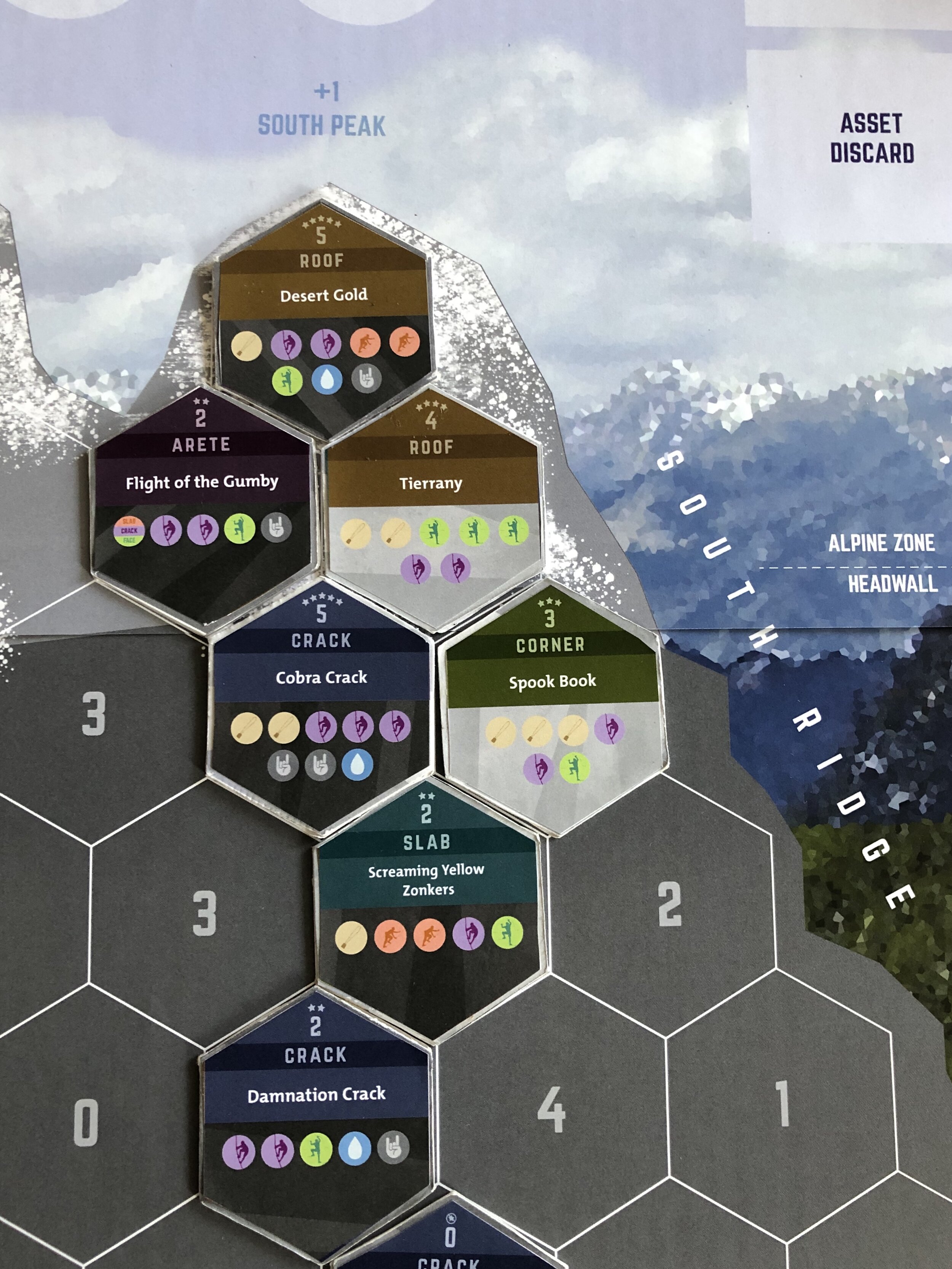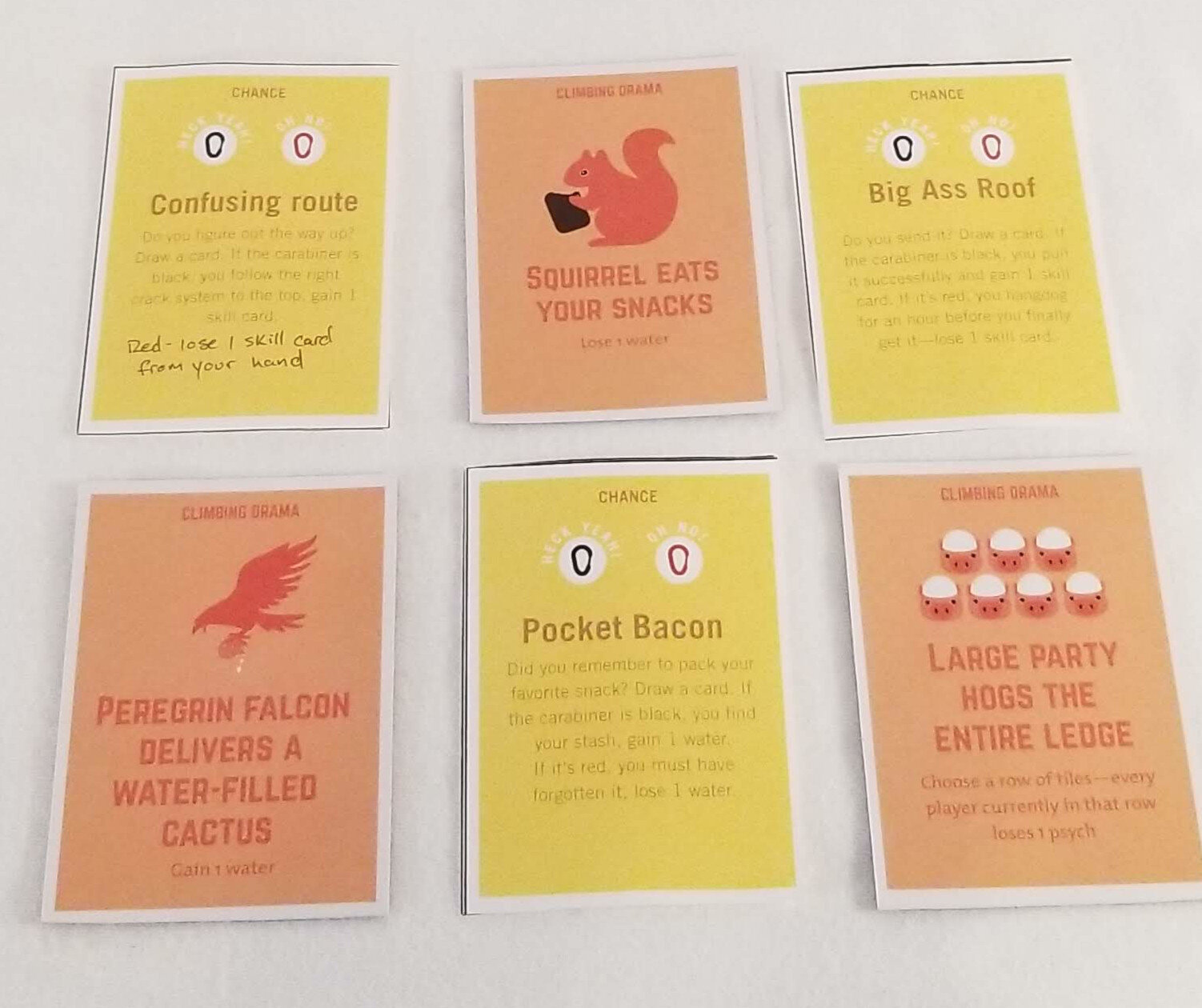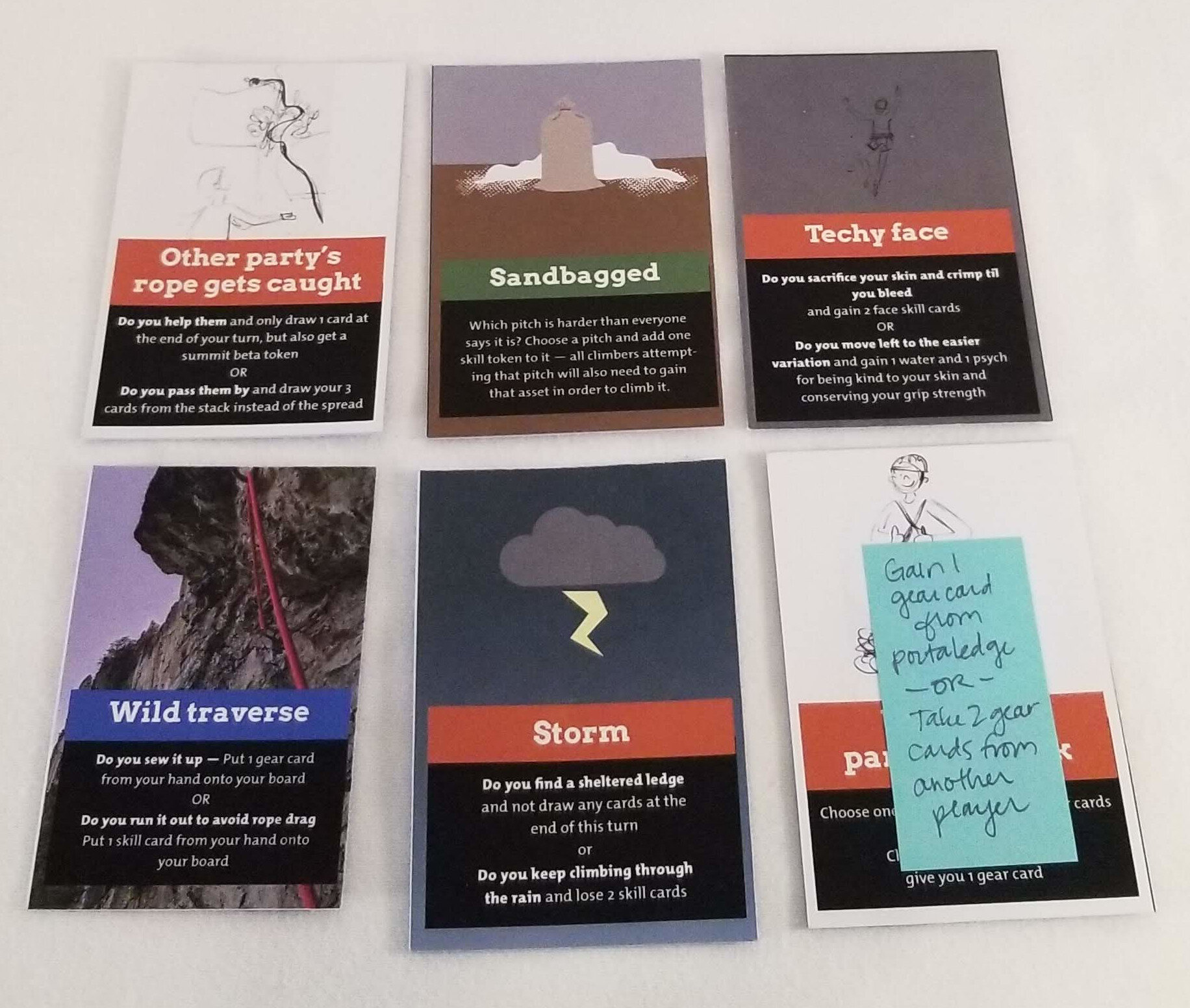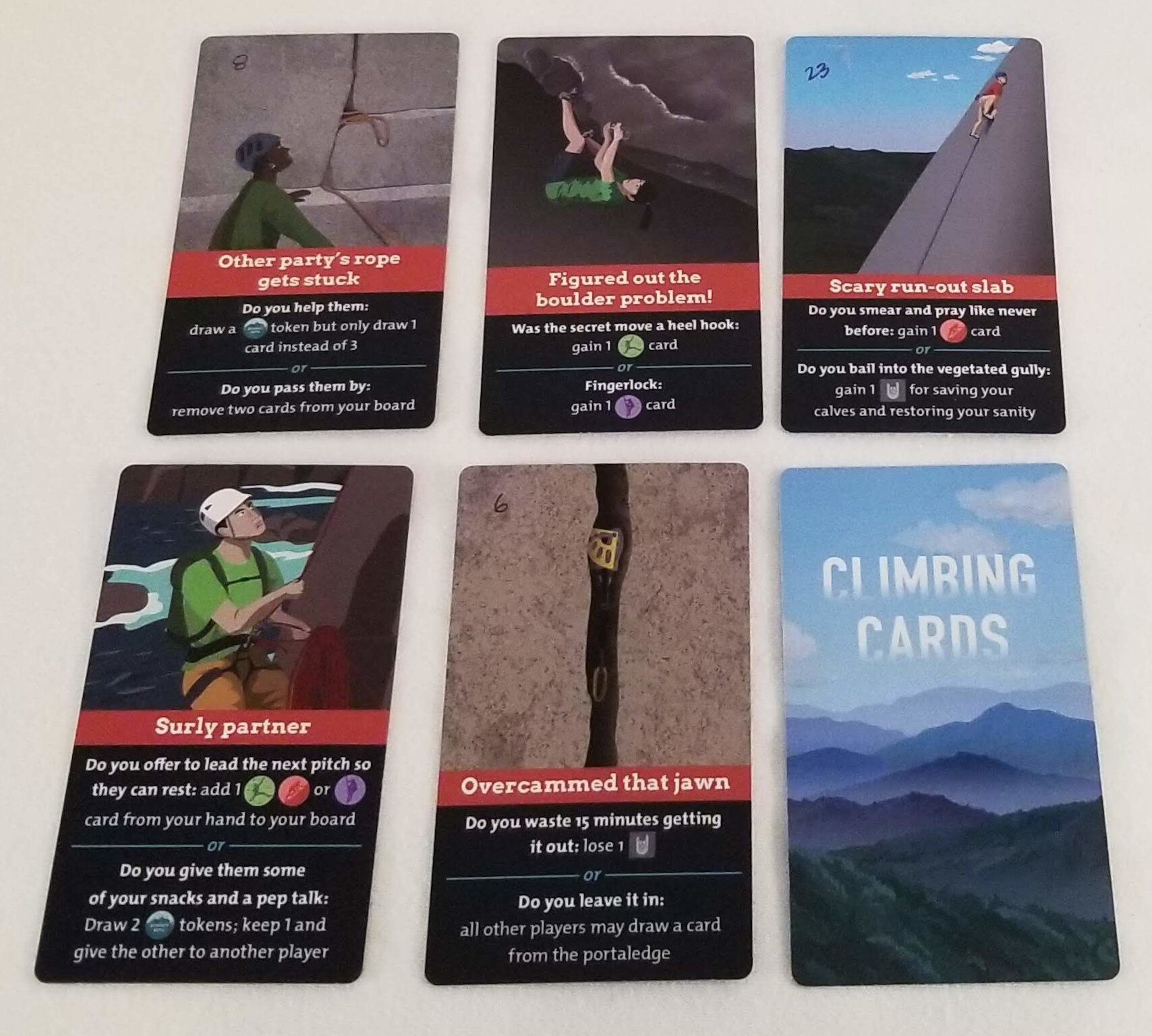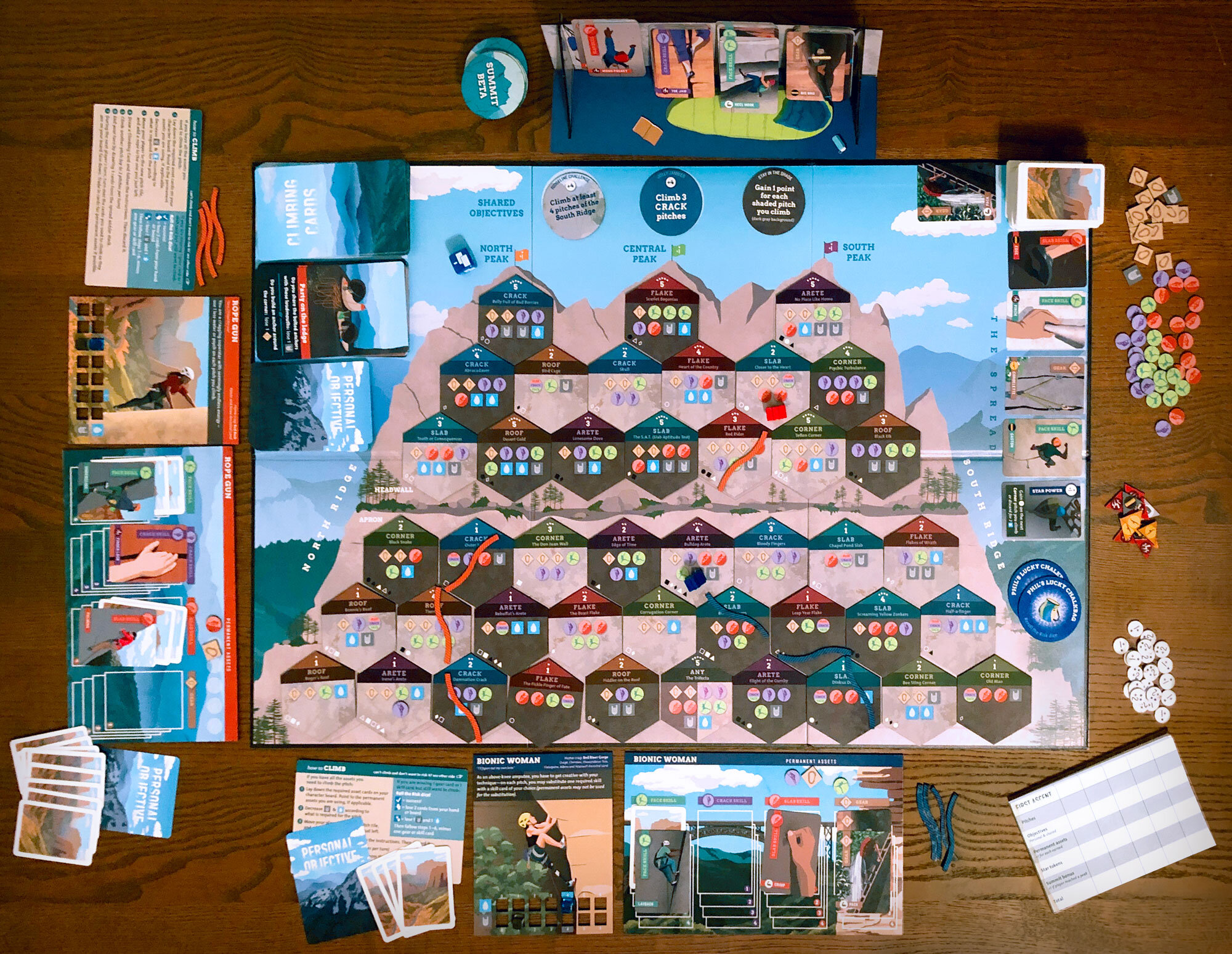The Evolution of First Ascent
Lessons for using your game’s theme to drive development
This post chronicles the journey of First Ascent from conception to our first prototype. The idea of First Ascent started with discussion about climbing partners. Originally, Kate joked with one of our climbing partners, Bob, that they should have baseball card-esque profiles of each of their climbing partners, used to recommend or warn against climbing with them to others— the partner who is really strong but never takes breaks, the one who is annoying but brings good snacks, etc.
This joke evolved into the idea for a tabletop game as we became engrossed in tabletop games, and learned a lot of our climbing friends liked tabletop games too. We realized that climber archetypes could make great characters, and there are so many scenarios that arise while climbing that could be gamified.
Characters
Some of the characters in First Ascent represent classic personas ubiquitous in the climbing scene, like the Dirtbag and the Rope Gun. They are also inspired by real life people we admire, such as Rebecca Levenberg as the Bionic Woman. Rebecca is a Philadelphia based rock climber and above-the-knee amputee with an awesome journey chronicled in her blog. We also included a character for our friend Phil, notorious for his risky moves and giving his all to go for the impossible. Other characters are based on people well-known in the climbing world, like the Bold Brit (Hazel Findlay) and Free Soloist (Alex Honnold/Brad Gobright).
After just a few playtests, it seemed obvious thematically that psych and water should be tied to the character and depleted throughout the game. We experimented with various character board shapes and methods of tracking water and psych. We tried 20-sided dice, paper clips on sliders, cards, but ultimately decided on punchouts with small acrylic cubes like in Dice Forge.
As part of the engine building aspect of First Ascent, characters improve as they climb by building permanent assets and gaining asset tokens. Characters also have asymmetric abilities which we are constantly refining through playtesting, using post-it notes to keep track of new abilities being tested. We’re still in the process of balancing character abilities, making them as engaging as possible and even adding additional challenge in some cases. Asymmetric characters not only make sense thematically (because all climbers are a little different), but it also allows us to highlight different mechanics of the game. The Sendy Jammer has an advantage for gaining technique points, The Dirtbag has an advantage for gaining permanent assets, the Bionic Woman has an advantage while climbing pitches. We also felt that asymmetric characters greatly contributes to the replay value, so that more experienced players can choose a more challenging character.
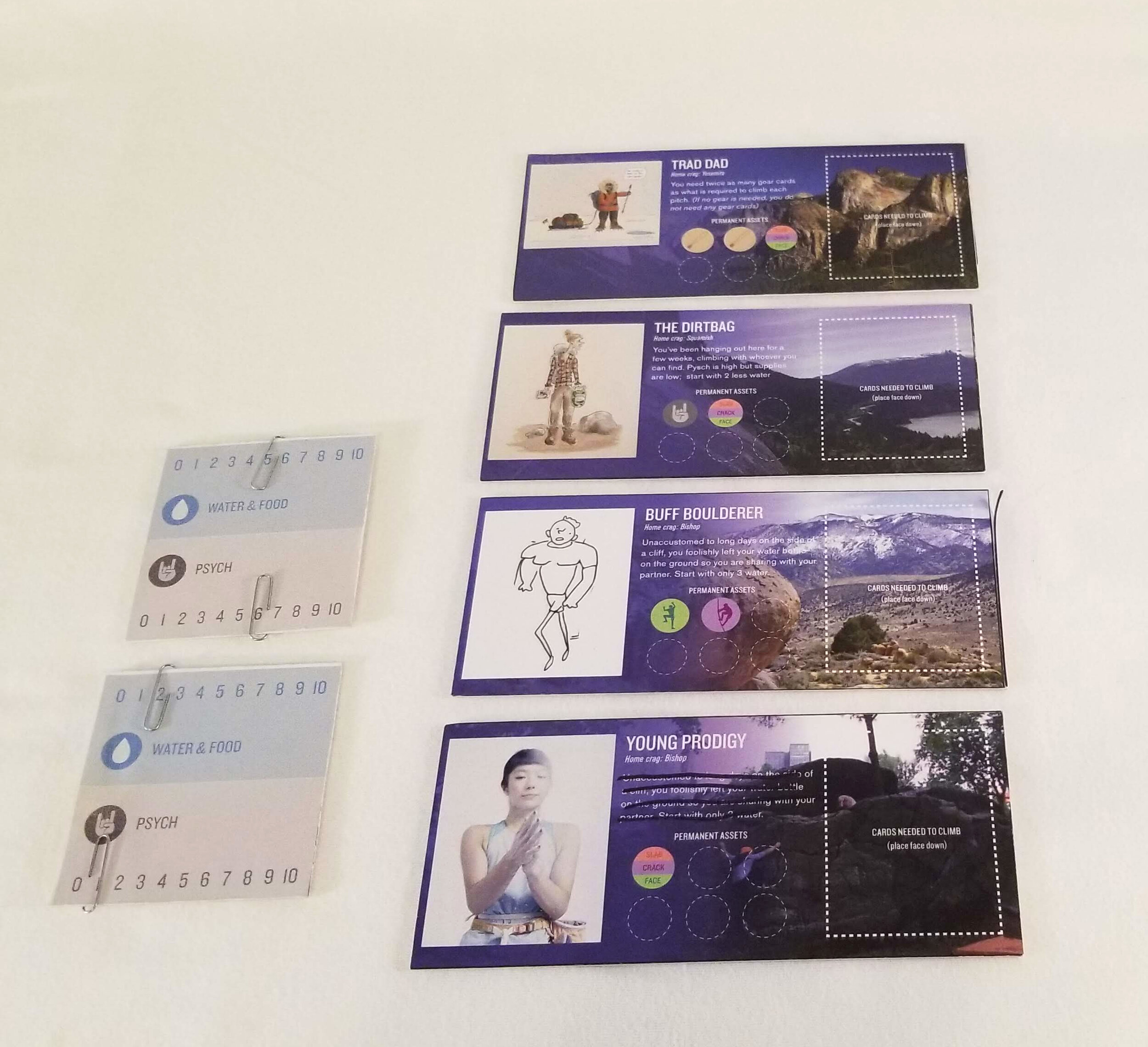
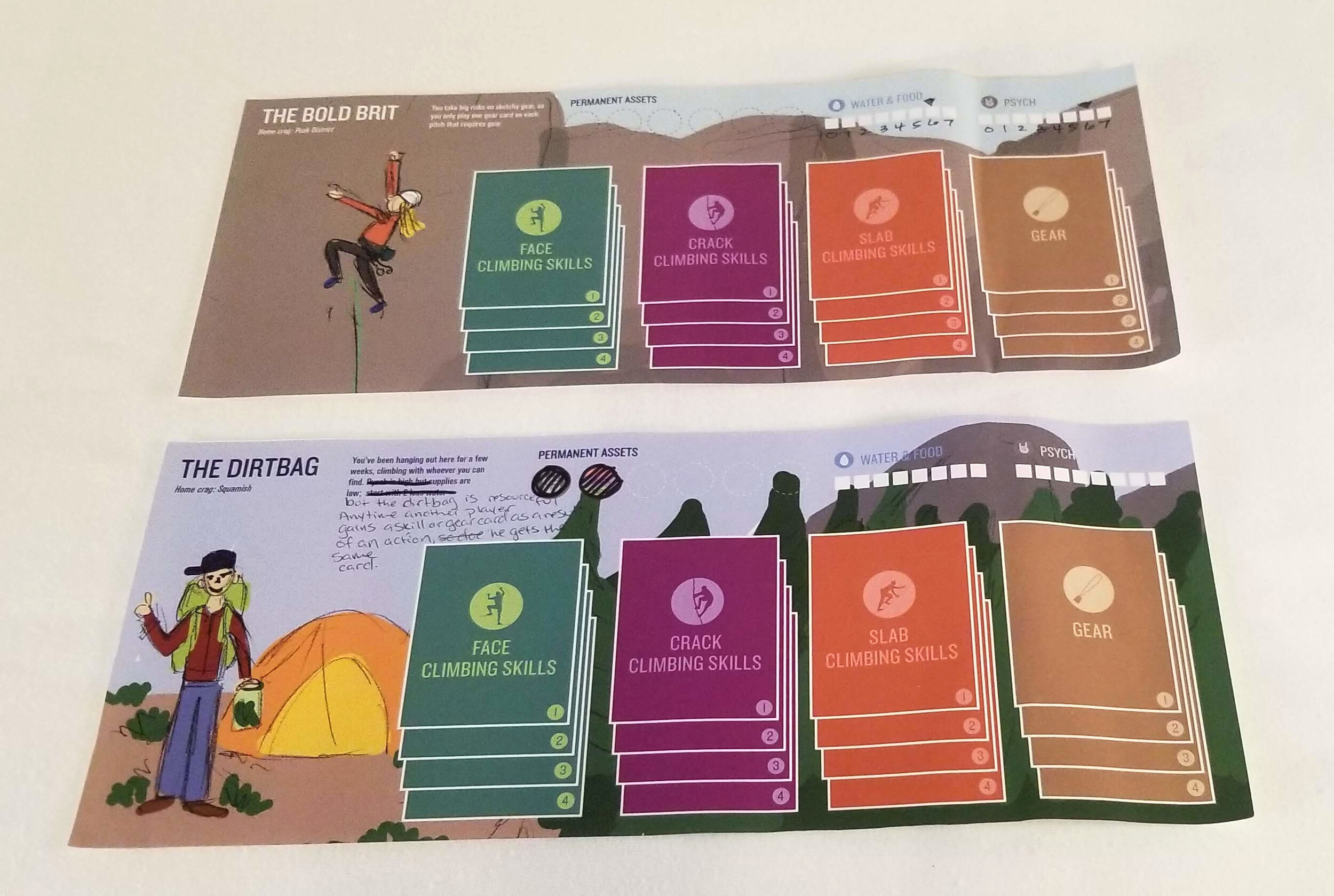
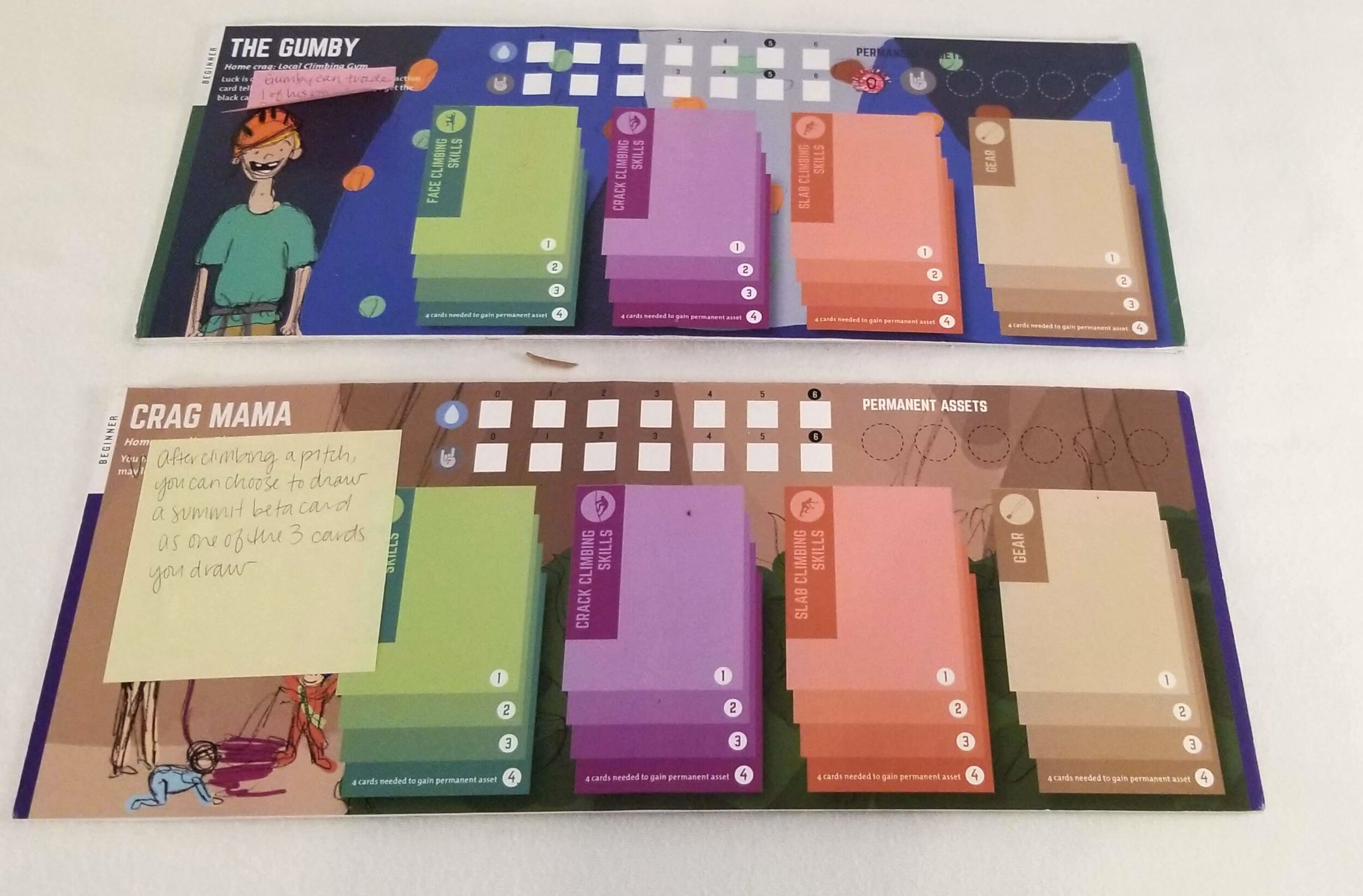
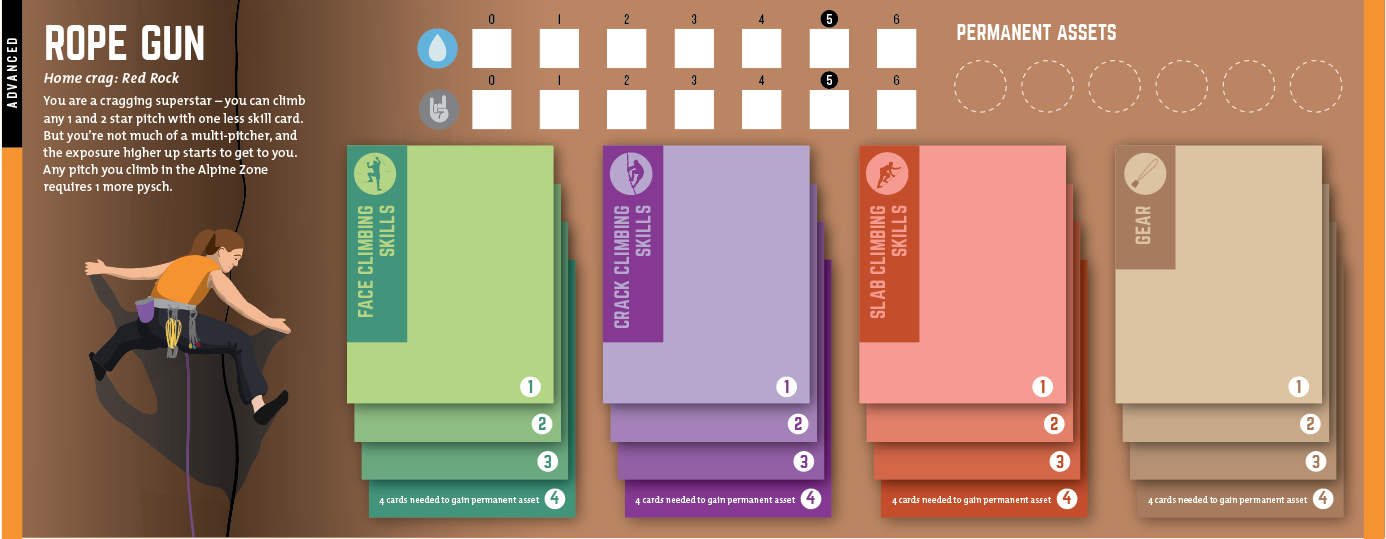

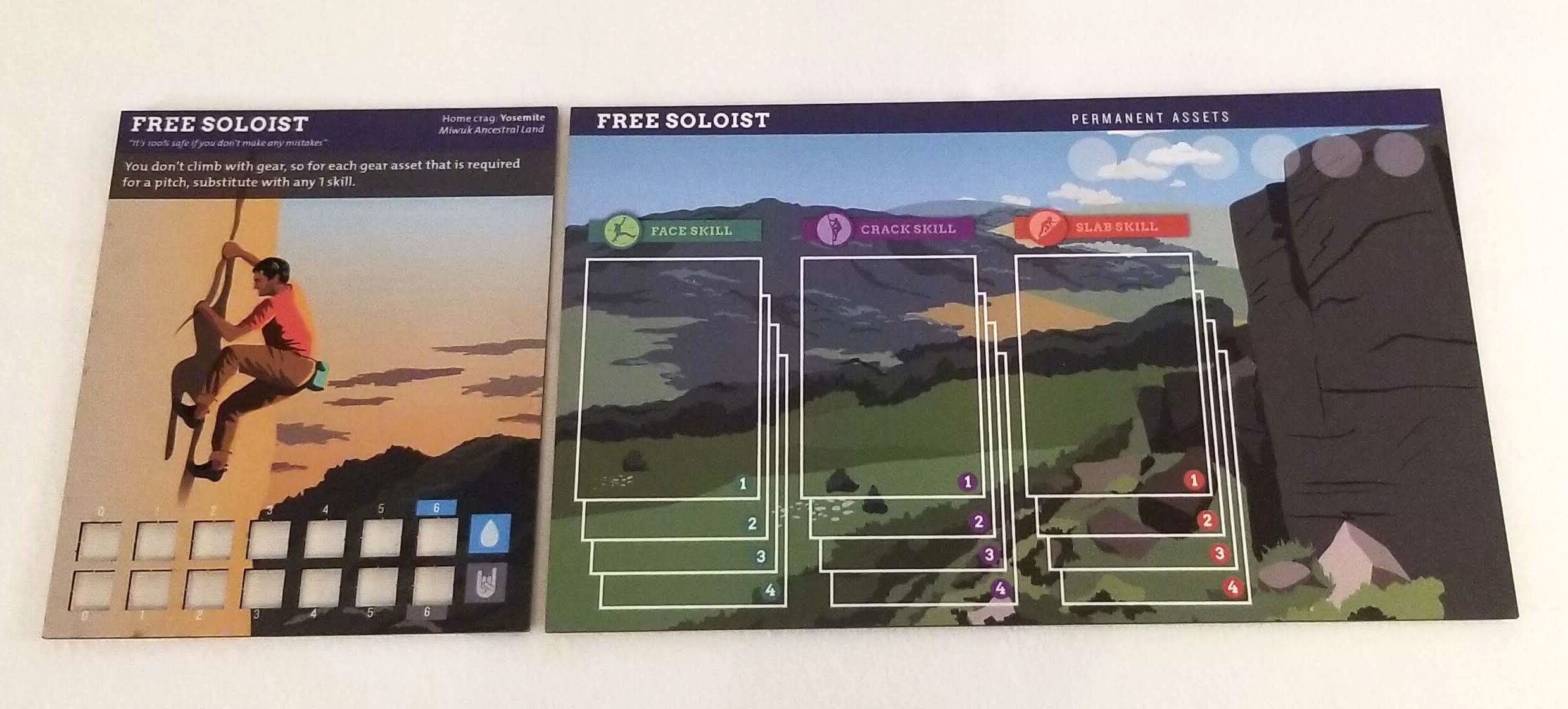

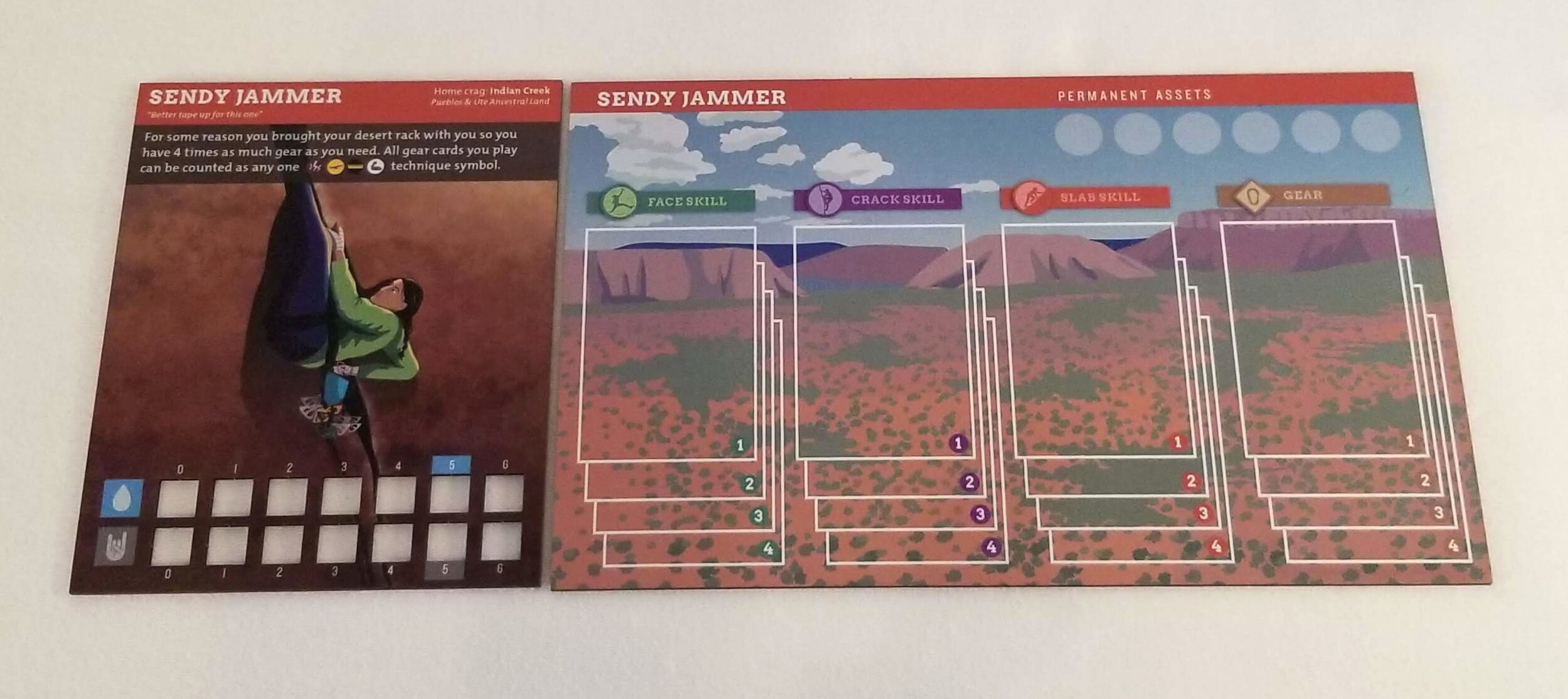
The Board
The mountain has gone through a number of iteration, starting with a single peak, but the concept of movable pitch tiles was a founding element. We experimented with “discovering” the mountain, in which each pitch was revealed when players occupied adjacent tiles. This made the game too much of a dungeon crawler, and we wanted players to have the information they needed to strategically plot their route up the mountain. We also realized the mountain needed to be wider to accommodate more players, and thus it became a mountain with three peaks! To balance the value of tiles across the mountain, we assigned the location of tiles worth 1, 2, 3 points etc. However each game the specific tiles vary at those locations.
In the latest version of the game board, we have introduced a ledge separating the lower “apron” and upper “headwall”. The apron tiles are face up at the start of the the game, but the headwall tiles are face down and revealed when a player reaches the ledge. The ledge allows players to move to any tile touching the ledge. The ledge solves two problems:
analysis paralysis - players were overwhelmed by seeing the entire mountain and trying to plot their whole route at the start of the game
log jams - occurred when players were stuck behind other players, forced to either wait or climb pitches for fewer points. We had originally tried to solve this through more rules—what you could do to bail, downclimb, or pass other players. But these were cumbersome, not intuitive, and added more rule exceptions rather than streamlining the game. The ledge gives players more mobility and opportunities to rethink their strategy.
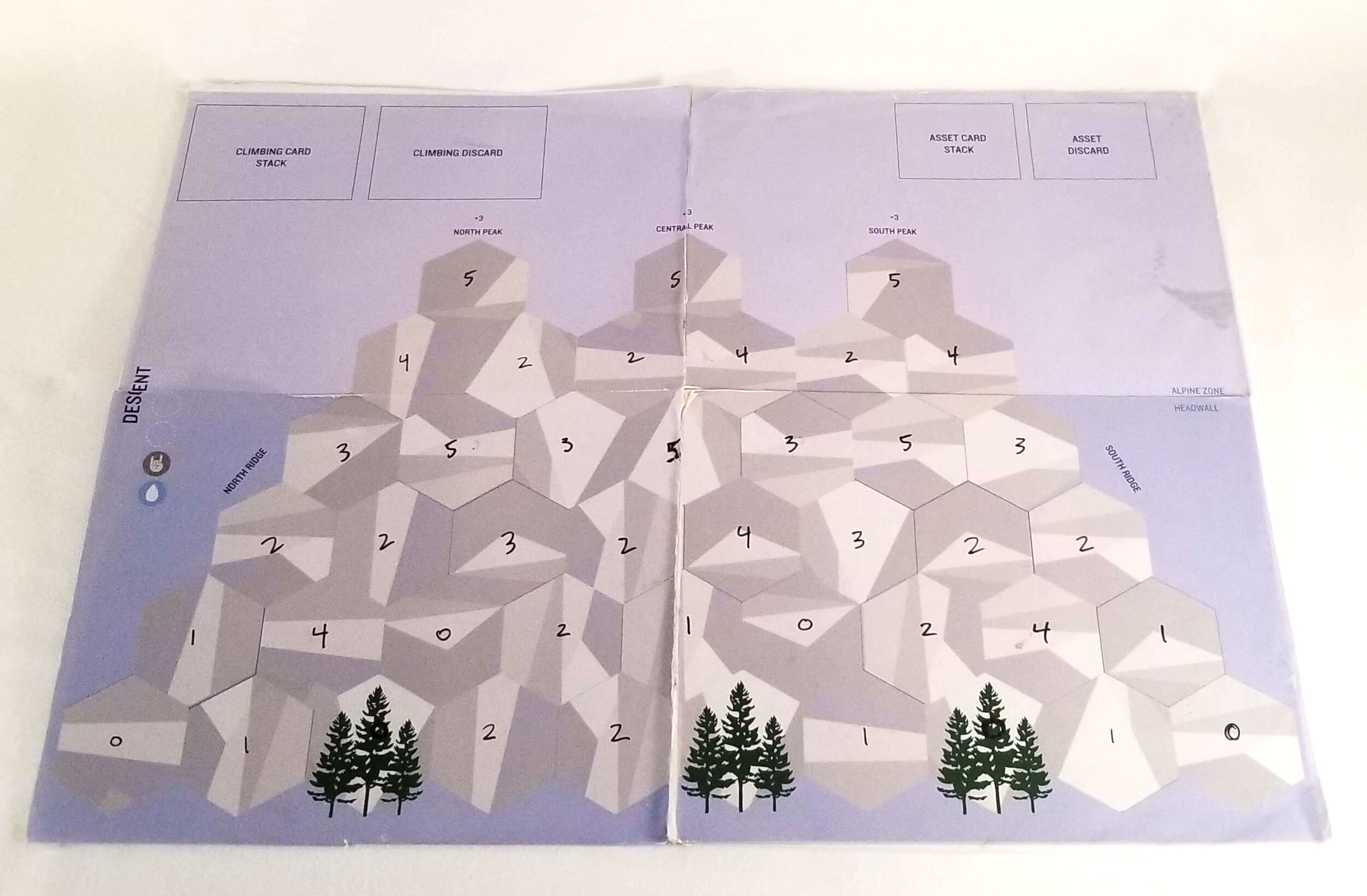
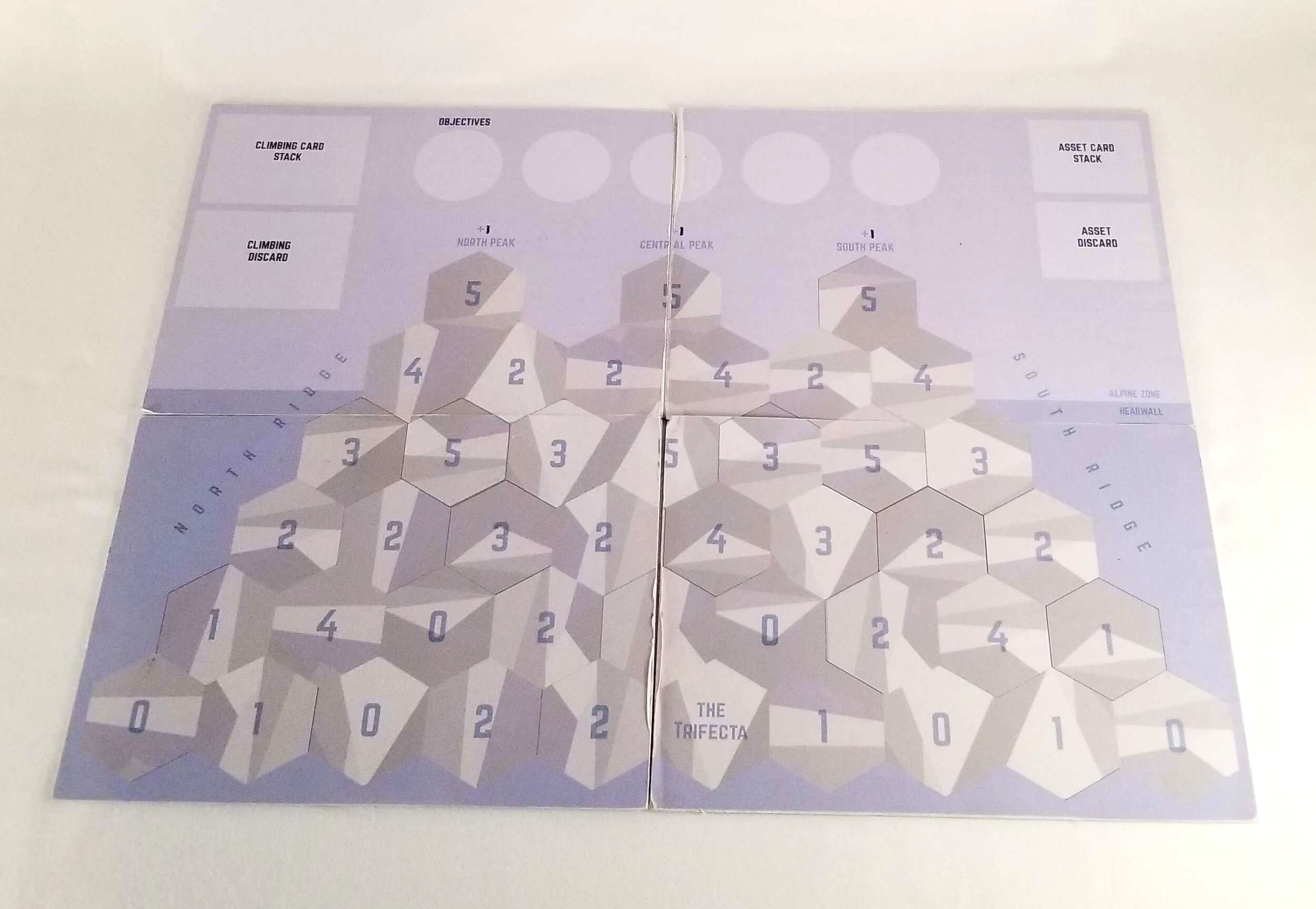
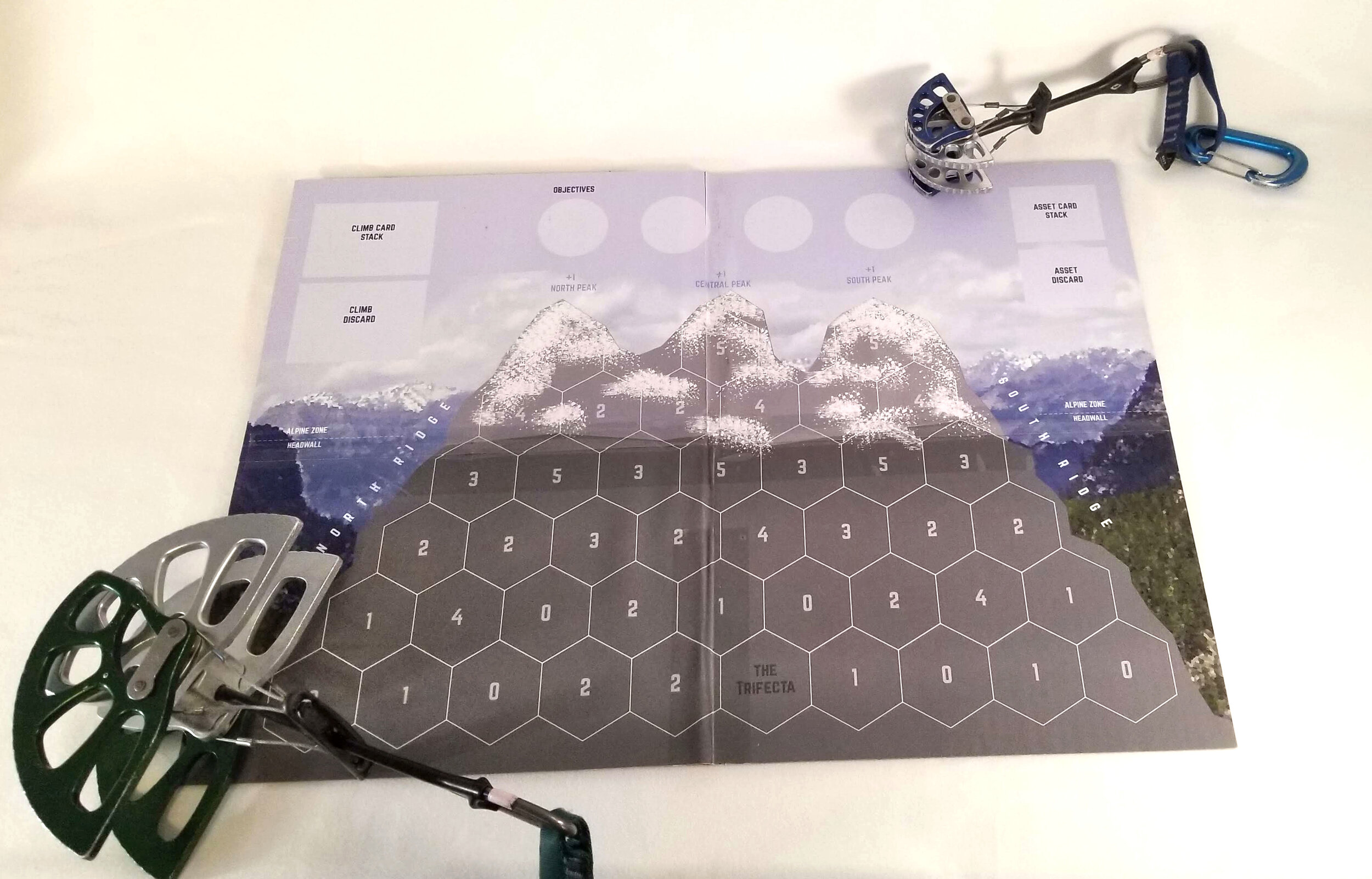
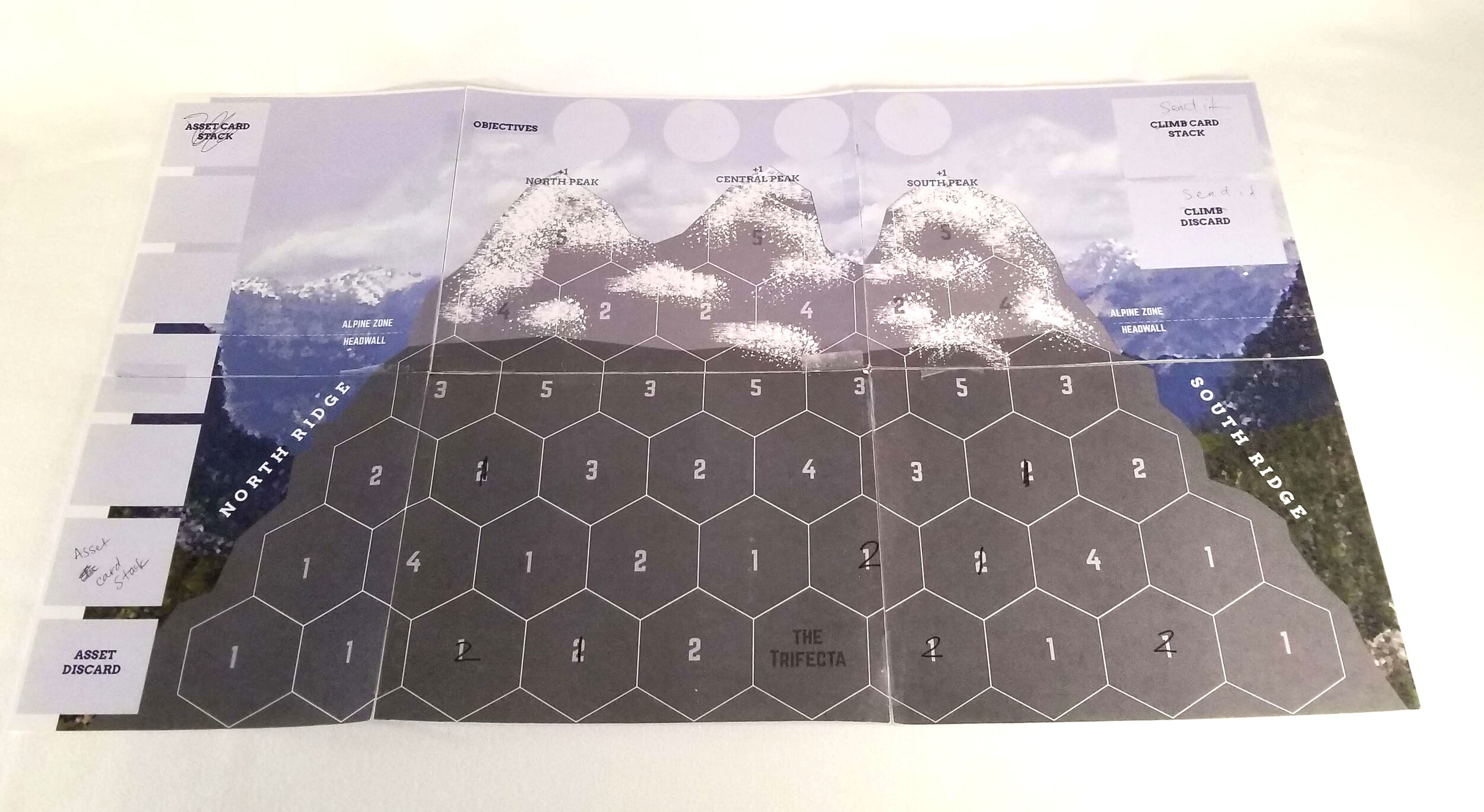
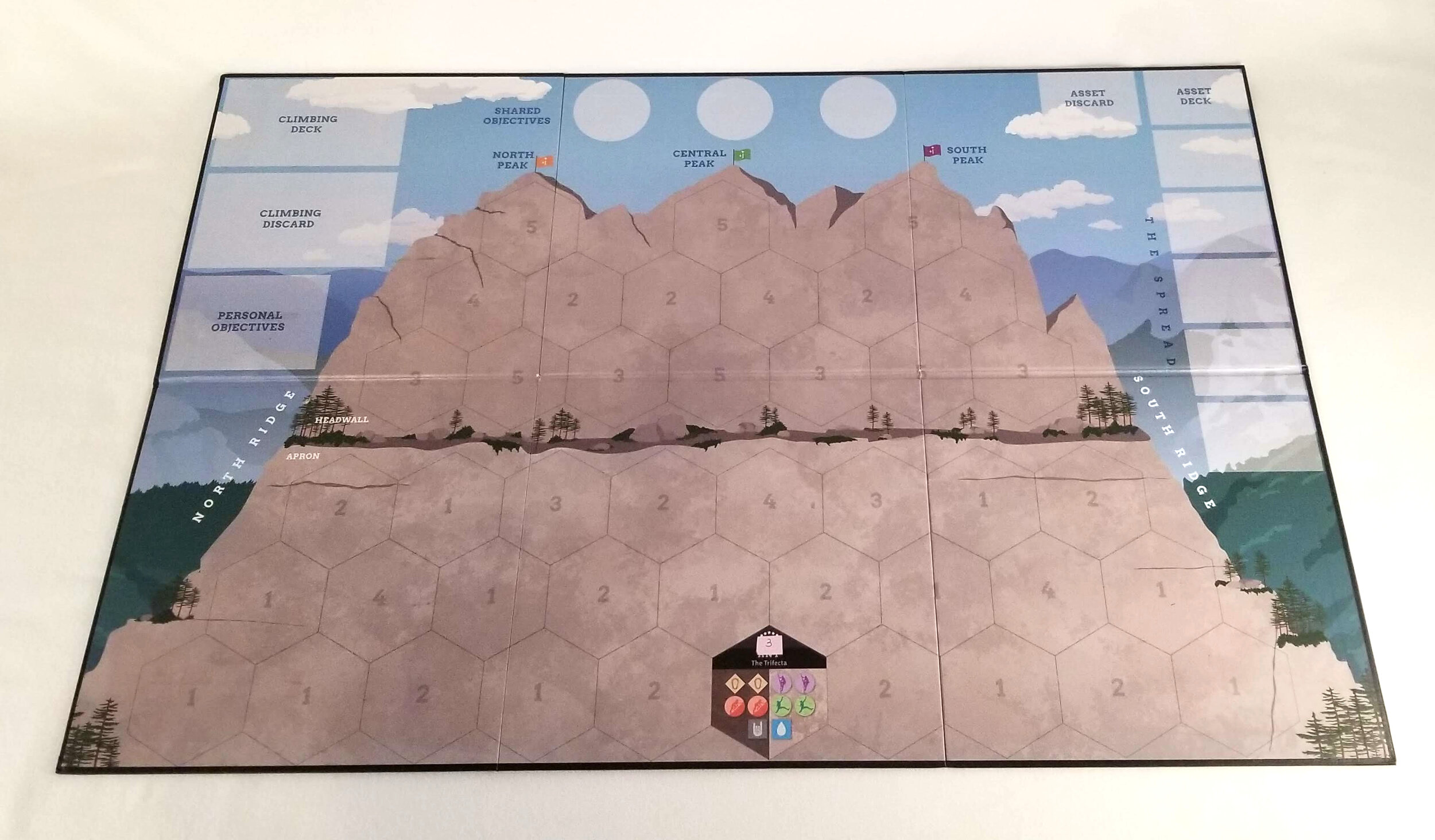
Pitch tiles and Objectives
The original concept for the mountain being made of different types of features—arete, crack, slab, roof, flake, corner—was inspired by Moby Grape, an 8-pitch route on Cannon Cliff. This route outstanding for its variety of natural features.
As the mission of the game evolved into “create the best route up the mountain,” we started thinking about what makes routes really special. It often comes down to it having one or several of these prominent features, hence inspiring the objectives for climbing 3 aretes, 3 roofs, etc. Sometimes it’s the routes position relative to the mountain that makes it special, like climbing a spire or ridge—which is what inspired the “North Ridge” and “South Ridge” objectives. Climbing in cold or hot areas forces an additional consideration: if the route is in the shade or sun.
Objectives have helped guide players plot their route and layered more strategy onto the route-building mechanic.
Early prototype of game board and tiles printed on paper, glued to cardboard, and cut out by hand.
Assets and Techniques
The assets that players gain by drawing cards are gear, crack skills, face skills, and slab skills. These assets are used to fulfill the requirements of a pitch when a player climbs.
The asset cards were conceived as a strong thematic element that could showcase a variety specific climbing techniques and gear. For most of the versions of these cards, they showed different skills and gear, but there was no reason to choose one type of gear over another or one face climbing skill representing a “pinch” over a “gaston” climbing move.
To give purpose to the specific cards within a skill type or gear, we added “technique symbols” to the bottom left corner. In real life and in the game, these techniques are not critical to climbing, but do make you a better climber—a climber with good precision is more confident on technical terrain, a climber who is strong climbs roofs more easily—and making a point to practice these techniques pays off in the long run. Matching technique symbols is an additional way to gain points as players climb. While this mechanic was originally “tacked on” to the game, it eventually became better integrated and served more purposes:
Introduced a new “catch up” mechanic: this was important to us, as we hate playing games where there is a clear frontrunner and no way to catch up. When cards are drawn strategically, any player can achieve extra points. This mechanic is often easier to achieve with lesser value tiles, since those require fewer cards, thus giving players the ability to choose which cards to play.
Build value into specific cards: Cards with a symbol become more valuable, and cards with multiple symbols became really valuable. This gives players reason for choosing specific cards, which is especially relevant for cards on the spread and cards on the portaledge. It also builds in a layer of strategy for when to play cards—players must decide whether to play now to move more quickly, or they could pass to gain a card with the symbol they need to earn more points.
Gives players a “now vs. later” dilemma when drawing event cards: players can choose to gain techniques or cards on some event cards, forcing them to decide between something that might gain them more points in the future if they play their cards right (technique), or something that they can use to climb more quickly (card).
The images below also demonstrate the evolution of the gear card artwork, from simple text, to the gear passively sitting on a rock, to the gear in action!
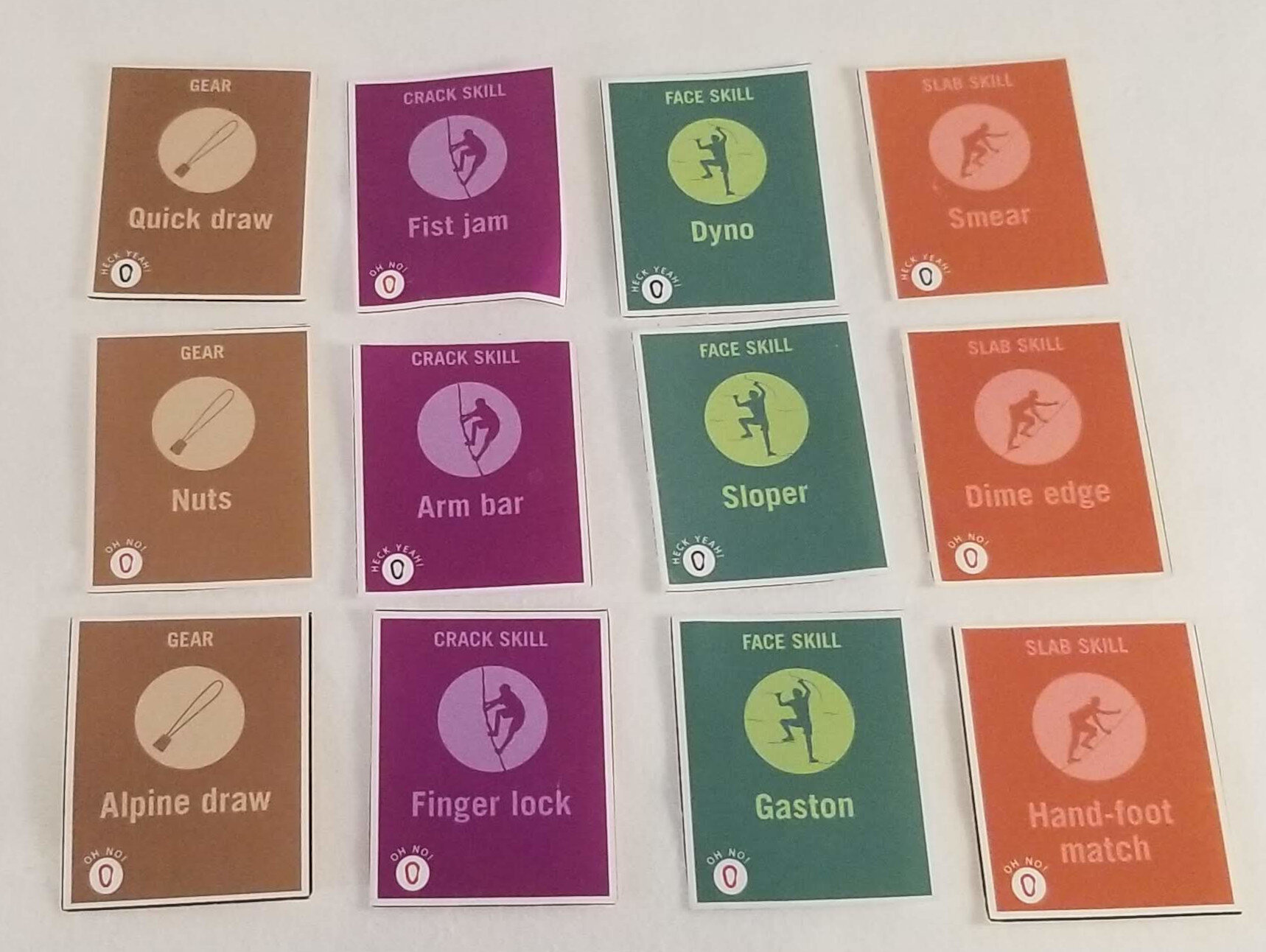
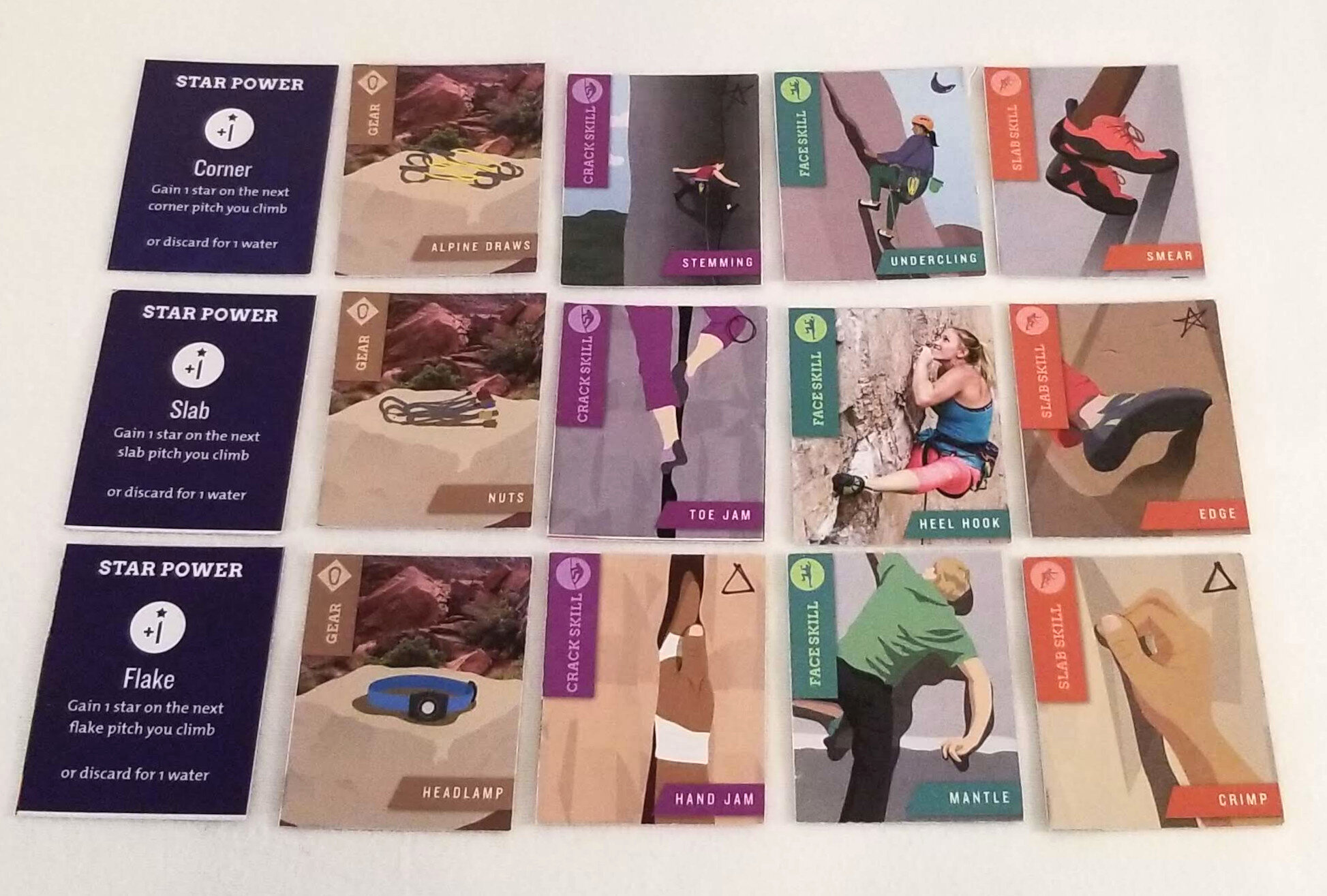

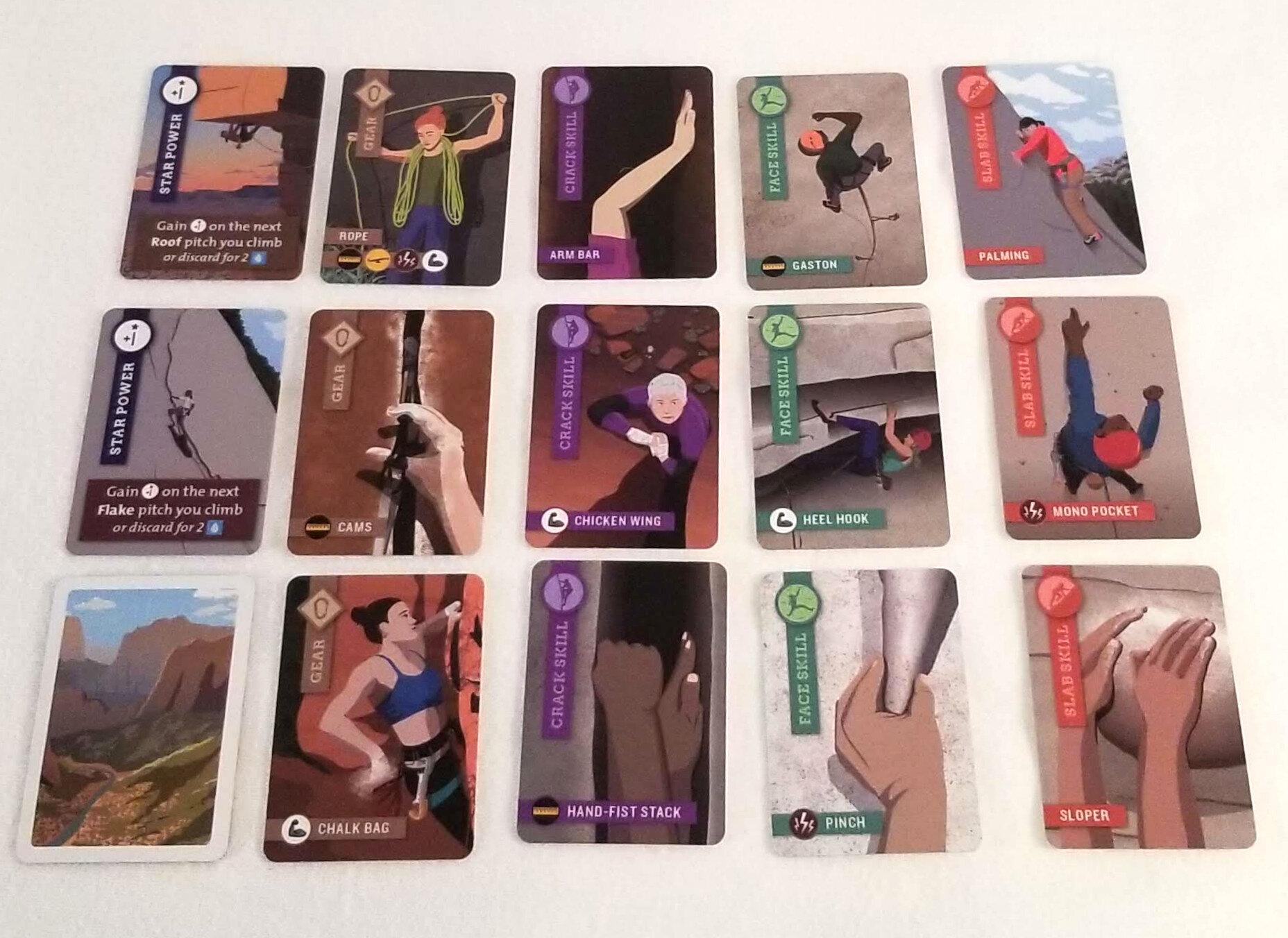
Events / Climbing Cards
In First Ascent, we are constantly balancing the elements of strategy and luck. Climbing is never certain and we want there to be some sense of discovery, but we don’t want the outcome of the game to be determined solely on luck. We are striving to design a game that requires strategic planning and decision making to earn the most points and win.
However, unexpected events happen frequently in climbing and climbers must make good decisions to achieve their goals and come home safely. While “event” cards are not a mechanic traditional to euro games, we felt that they were critical to the theme.
This deck and flavor text has been part of the game from the beginning, but the mechanics of these cards have changed considerably. We are continually refining the Climbing Cards in order to give players a sense of discovery, while reducing luck-based swing and give players strategic decision making capabilities.
Dice roll versions: The deck originally was highly reliant on chance, where players drew a card or rolled the dice for a positive or negative outcome from the event. However, this degraded the experience of a strategy game, since players had no control over the outcome of the dice. These were removed and replaced with some cards that had a slightly less positive outcome, and cards with a slightly less negative outcome. This positive or negative outcome still felt too random when one player would draw all negative climbing cards.
Choice cards: The next iterations of the deck allowed players to choose between two positive outcomes or two negative outcomes, the idea being that they could strategically choose which one would benefit them the most or hurt them least. There were an equal number of each in the deck, so we felt that every player would draw roughly the same number of each. Still players felt that these were too swingy, even when minimizing the impact of negative through their choices.
Choice cards with a cost: Currently we are working on balancing Climbing Cards to allow players to manage their resources through their decisions and make the cards more neutral. There are still 2 choices on each card, but both choices directs the player to lose an asset in order to gain a different one.
We have really enjoyed the introduction of board modifying cards such as the “wasp nest” which allows the player to flip a tile and make it inaccessible. We have also introduced cards that allow players to have a small gain for themselves, or a great gain that is beneficial to all adding an element of karmic and altruistic decision making.
The Risk Dice
In early versions of the game, some event cards would force a player to retreat from a pitch they just climbed. This built a lot of anticipation and suspense when drawing the event cards, but it was a really terrible feeling to retreat. Some playtesters liked having some element of holding their breath for the outcome, but didn’t want the stakes to be so high. Other playtesters didn’t like any element of chance.
We also observed and heard that “resting,” or passing on your turn, is the least fun part of the game, and we wanted to reduce that as much as possible.
These two concepts came to life in the game as The Risk Dice. This is an optional push-your-luck mechanic—a player may choose to roll the risk dice to forego one required asset of a pitch, but it may come at a price. Players may roll a check mark with no consequence, lose two cards, or lose a water and a psych. Players are successful if they can pay the cost shown on the die, or retreat if they can’t. Because the faces of the risk dice are “knowns” (and 1:3 chance of each), players can choose to roll when they know they will be able to pay the cost, and thus successfully climb.
The risk dice gives players an alternative to resting, and thus speeds up the game a little, as long as players are willing to take a chance.
Playtesting
A vital aspect of game development is playtesting. We are new game developers and adopted this approach instinctively, asking our friends early on “hey is this any good?” We have playtested First Ascent with climbers, gamers, people that do both, and people that do neither! We are especially lucky to live in Philadelphia and playtested First Ascent in the unpub hall at PAX Unplugged in 2019.
Feedback from others was essential for the evolution of First Ascent and most of the changes described here came from playtesters. This is a huge topic we will cover in a future blog post. The major concepts we focused on in playtesting:
what did people find confusing? what did they consistently not understand? Is it a problem that could be solved graphically/physically, or was it an issue with the rules? An example of this is that we found people were discarding asset cards into the event card pile. This was solved simply by making the decks two different sizes.
which mechanic, thematic element, and “feeling” of the game delights people—This helped us determine which elements to keep, evolve, and highlight. The feeling is especially important, because it’s not necessarily tied to a specific mechanic or gameplay experience. You can change the game significantly and create a similar feeling, which is ultimately what many players look for.
consider playtester’s gameplay and strategy as we listen to feedback: many times we found that the player who lost had the most grievances against the game. This doesn’t invalidate their feedback, but we always tried to determine if there were other factors in play, such as them not fully understanding the rules, not utilizing their character abilities, choosing to ignore objectives, etc that were the real cause of their problems, and wouldn’t be fixed by us changing the game. Conversely, if a player won by a long shot, we studied their gameplay to see if certain elements were overpowered, if they were just lucky, or if they won by capitalizing on specific mechanics effectively.
But I will point out that the it is important to let playtesters know what kind of feedback you are looking for and ask specific questions. We also found it is important differentiate between personal preference and real aspects of the game that aren’t working.
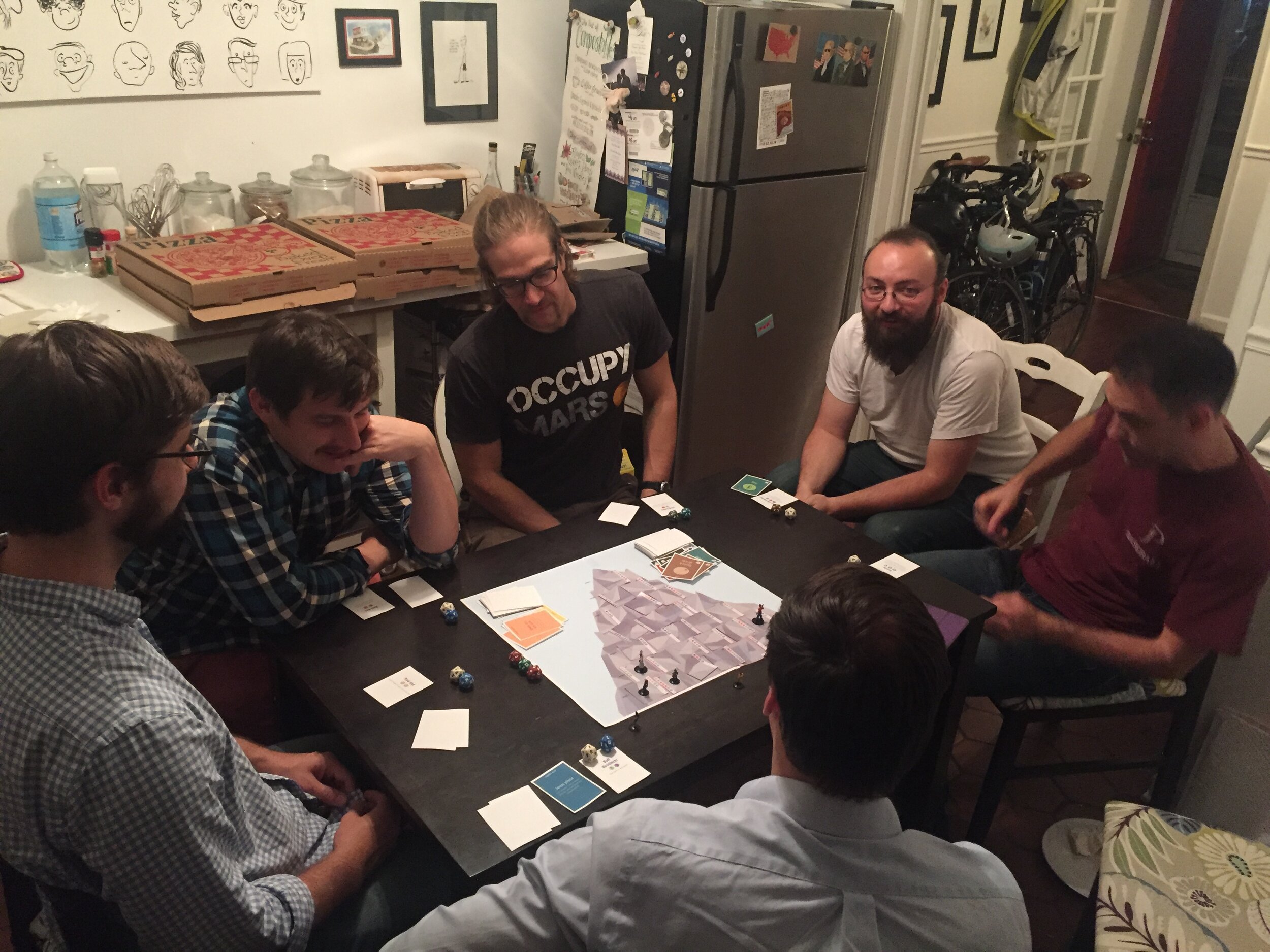
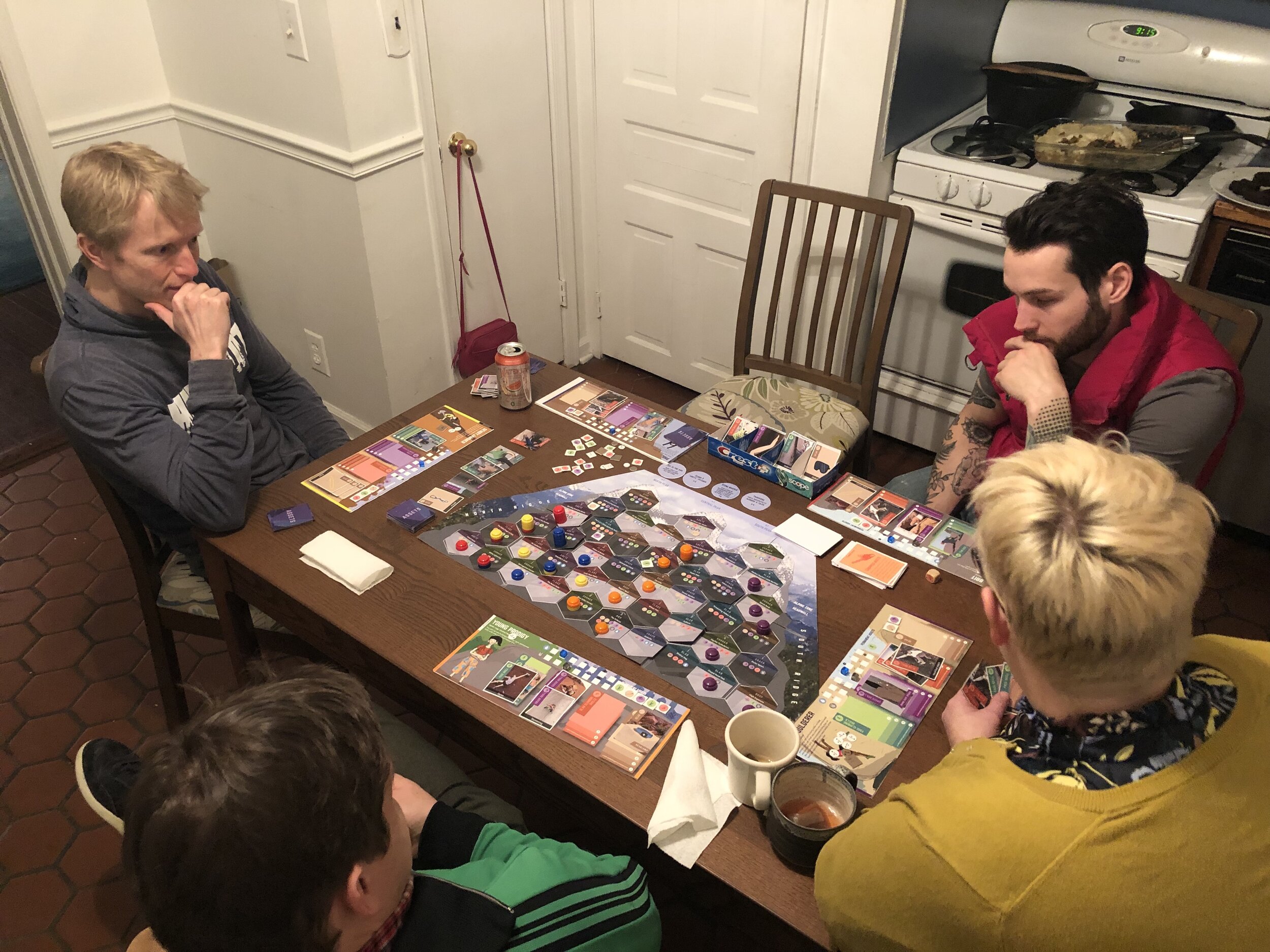

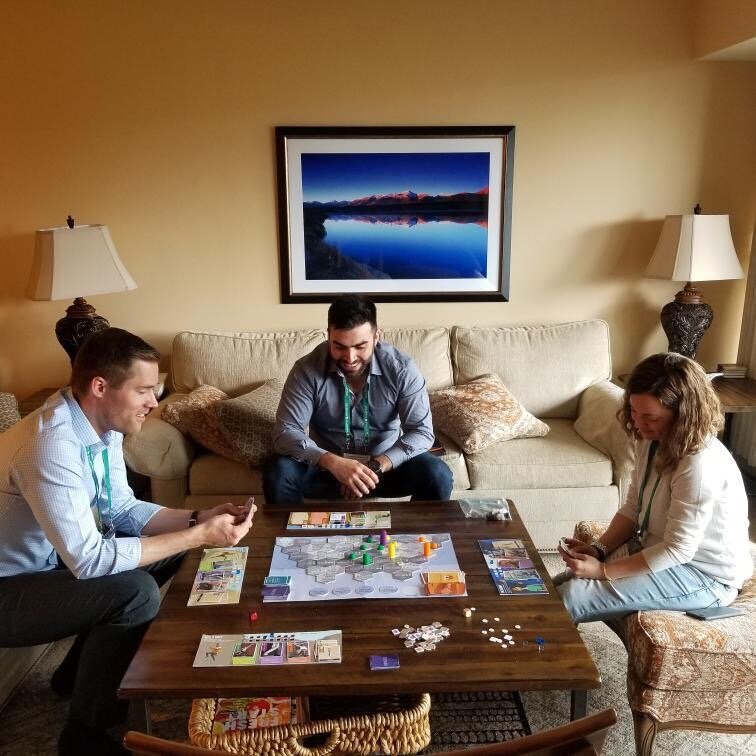
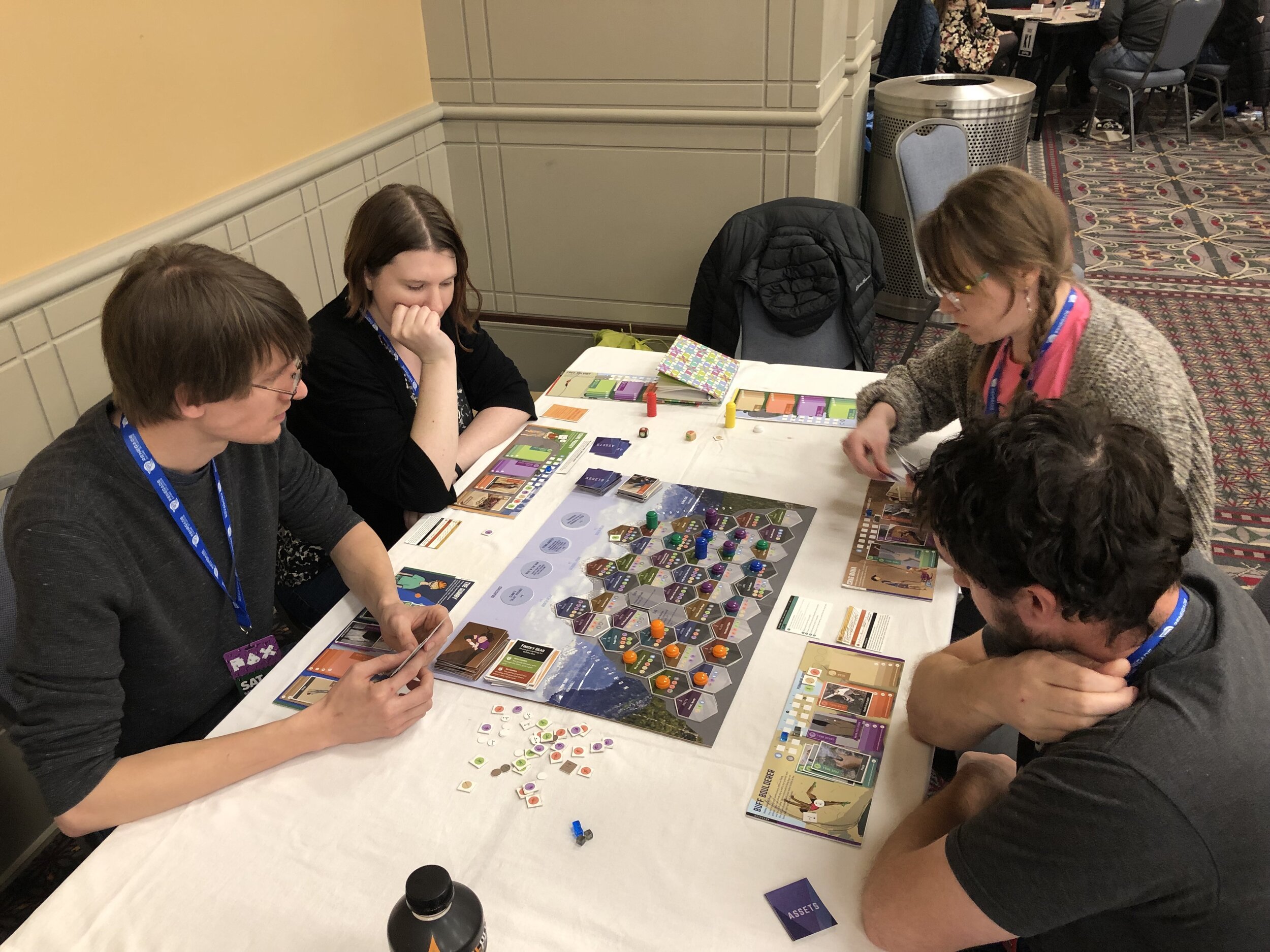
Tabletop Simulator
In order to access more playtesters, given the COVID-19 pandemic and cancellation of many game conventions, we uploaded a digital version of the game to Tabletop Simulator. There was a bit of a learning curve, but luckily there are many great resources available to learn how to play, create, and playtest on Tabletop Simulator. After learning the basics, some elements of refining the game were even more rapid than usual because we didn’t need to print and cut out pieces to play the game; we could upload the changes to Tabletop Simulator and test them right away. After uploading the game, Garrett became inspired to learn a bit of scripting to automate the game set up. He followed the excellent tutorials of the Ludo Lodge YouTube channel to learn scripting in Tabletop Simulator.
Although initially intimidated by Tabletop Simulator, as it has allowed us to play our games with many new friends we’ve met online all across the country and internationally. We would not have had the opportunity to get these playtesters valuable feedback if we were only using physical versions of the game for playtesting. We will launch a preview version of First Ascent as a mod on Tabletop Simulator in early 2021.
Screenshot of First Ascent on Tabletop Simulator.
The Prototype
After more than 100 play tests and many DIY iterations of First Ascent we finally ordered a high quality printed prototype from The Game Crafter. They are the go-to for one off and small scale print runs of game prototypes.
The first edition prototype printed by The Game Crafter.
One exciting aspect of the prototype is that we did not have to manually paste printed paper to cardboard and cut all 42 hex tiles by hand. Instead, all the hex tiles, character boards, and tokens were laser cut in 60 pt chitboard. Kate organized all the printed designs into a template that demonstrated the size of the “large custom punchout” and then define the laser cut lines. We also added our own images to the template for the 6-sided dice for custom screen printing the “Risk It” dice faces.
Design of “Large Custom Punchout” for laser cutting prototype hex tiles, objective tokens, and star tokens.
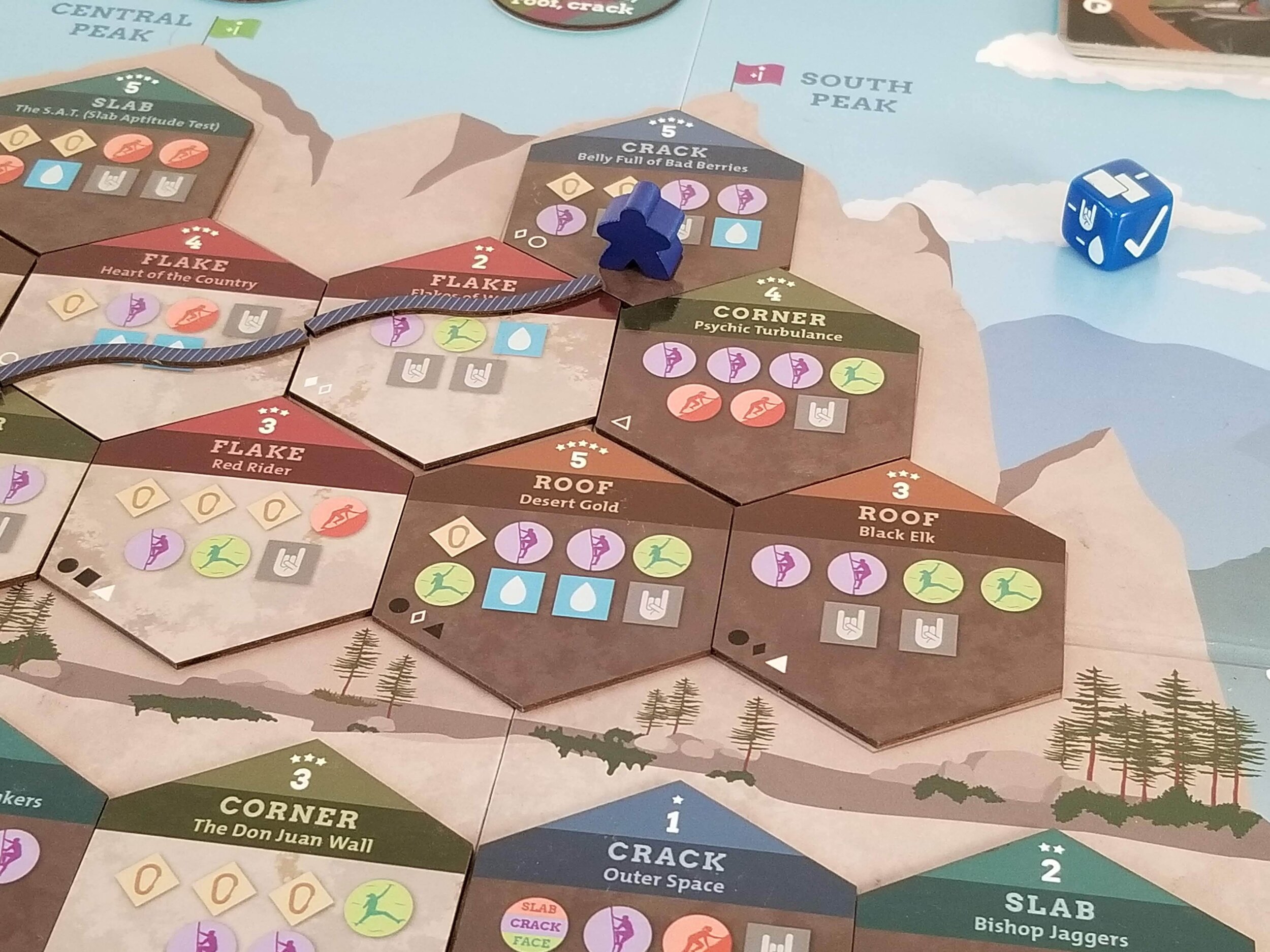
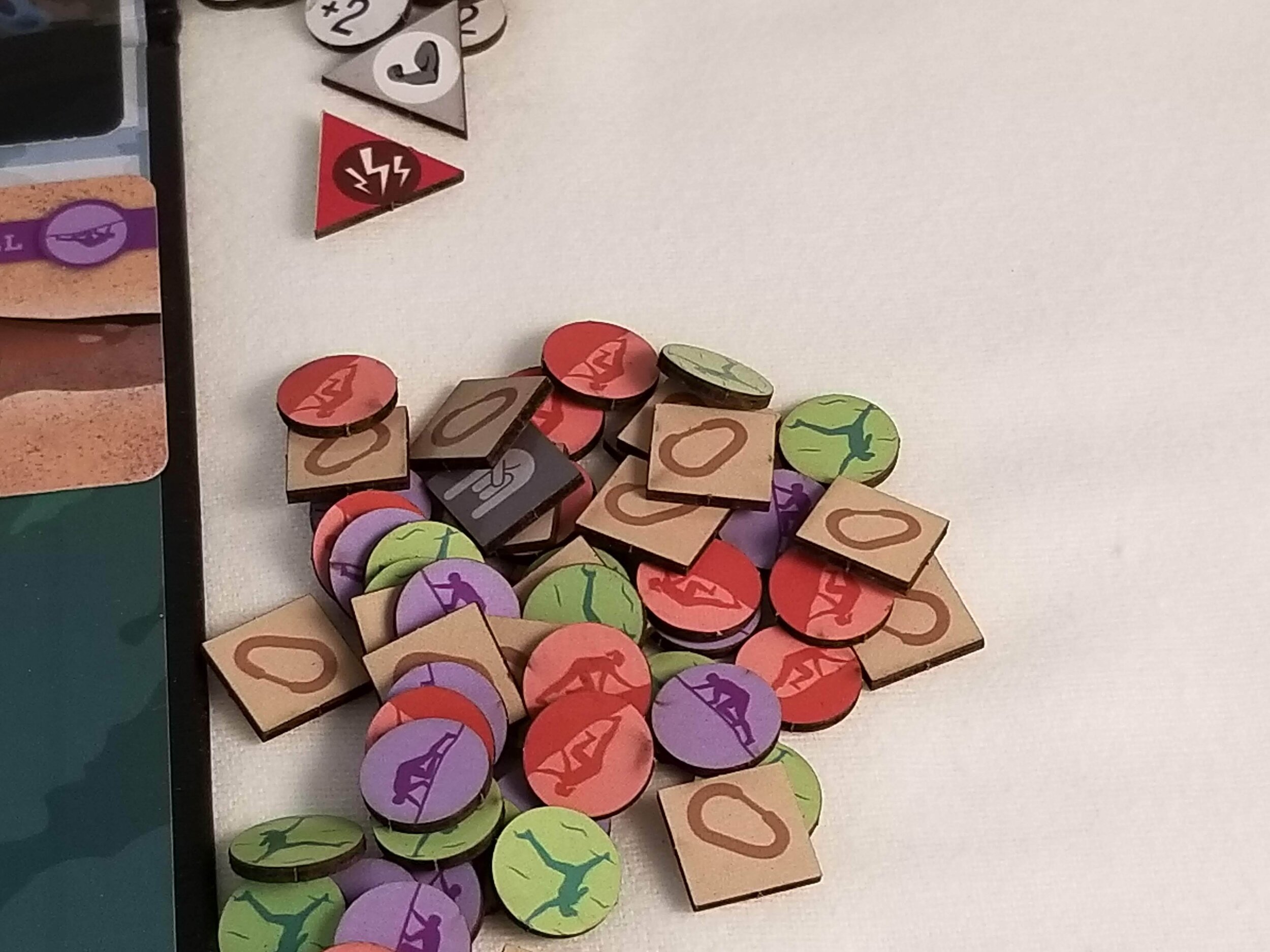
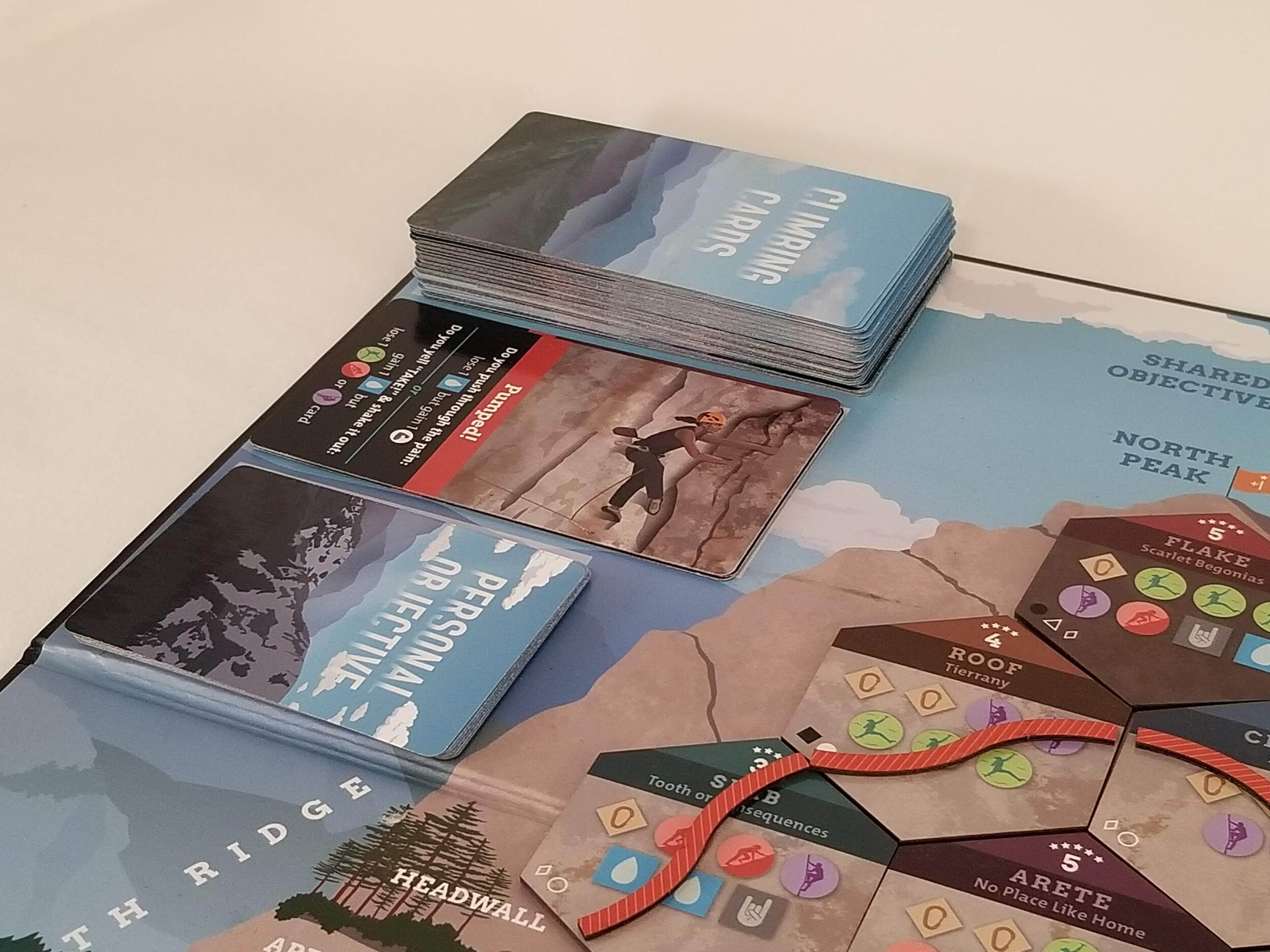
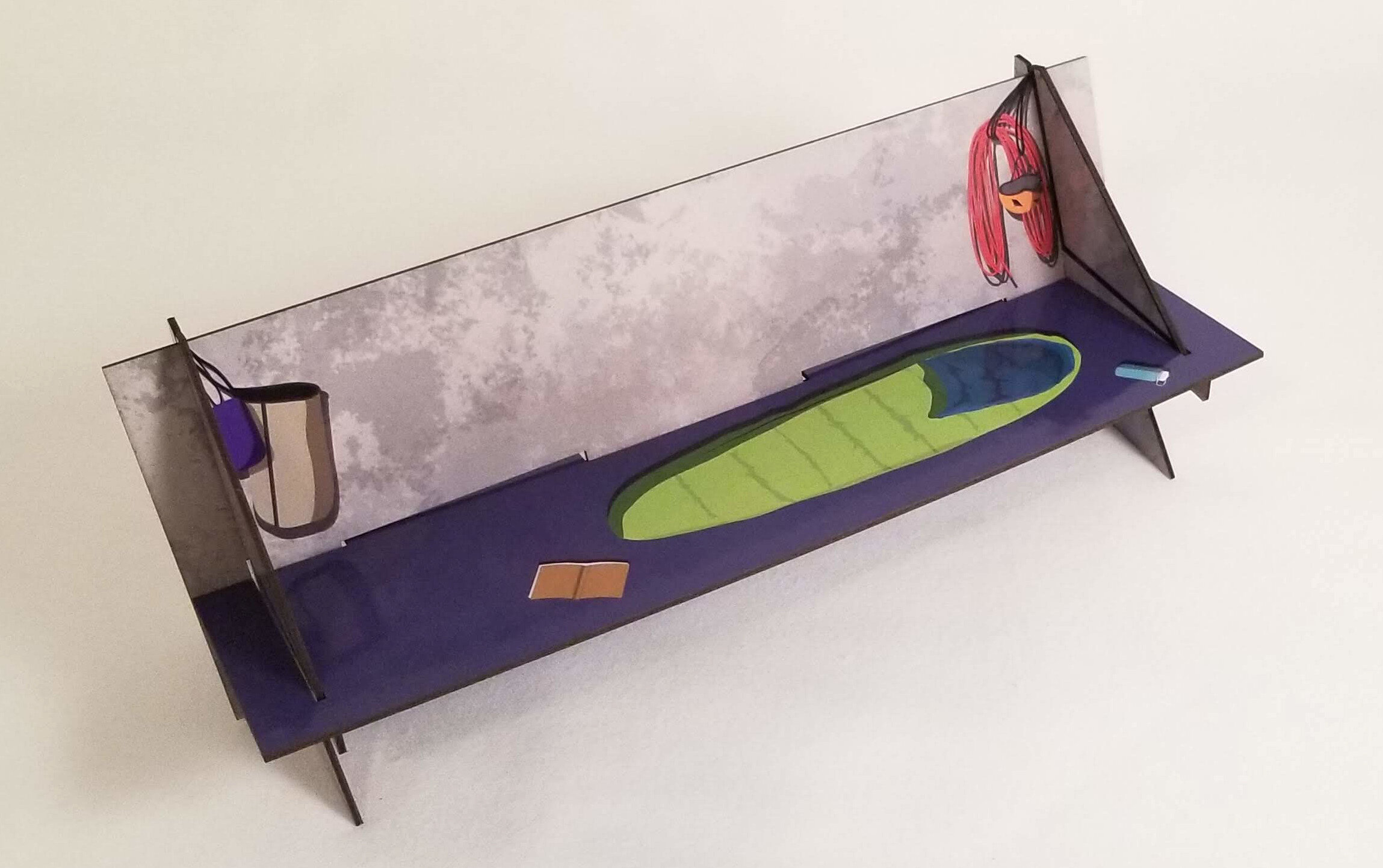
Unboxing the printed prototype of First Ascent from The Game Crafter was one of the most exciting moments in this process. To see the game printed in such vivid color on high-quality card stock and unfolding the beautiful 6-fold board was a very special moment. We are so thrilled with the print and component quality. Garrett had a moment imagining all our friends and Kickstarter backers opening their version of First Ascent and being so psyched. This gave him a burst of inspiration to share this journey with others and we’re so looking forward to sharing First Ascent with as many people as possible!
Finally
Don’t forget to make a sweet box.
Follow along as First Ascent continues to improve and we ramp up to our Kickstarter launch in April 2021 by signing up for the newsletter below. Leave a comment and let us know if you’d like to learn more about any of the topics touch on here and feel free to reach out to us with questions about using Tabletop Simulator or creating custom punchboards. We’re happy to discuss our experience using The Game Crafter and offer whatever help we can.
—Garrett and Kate


